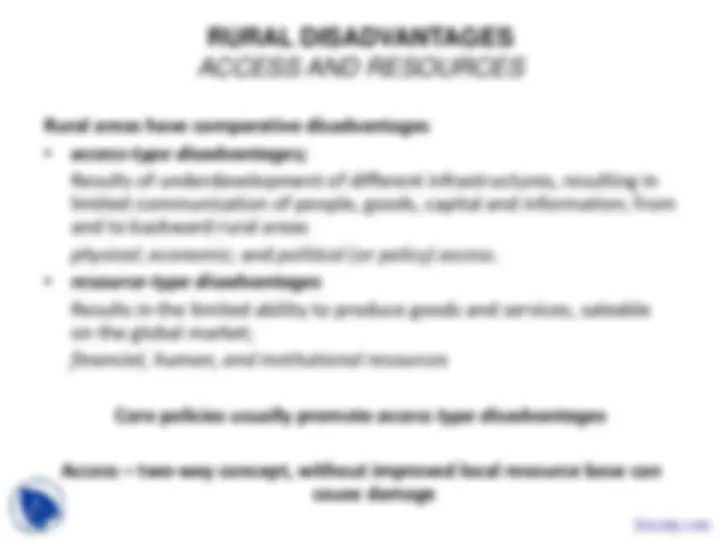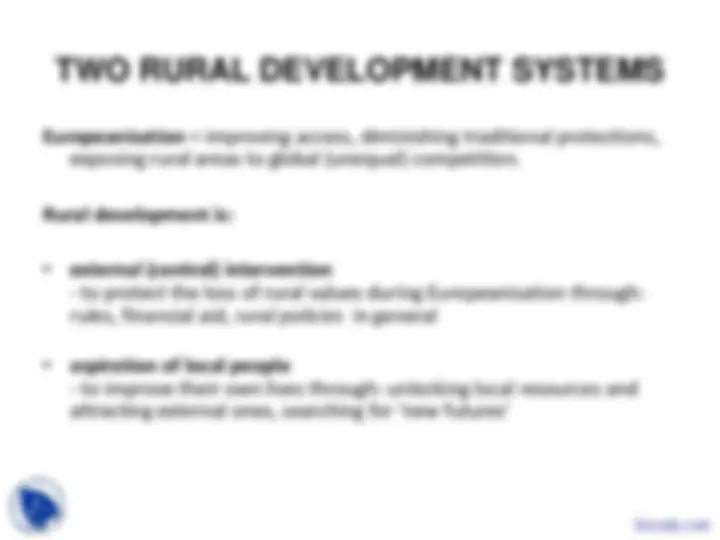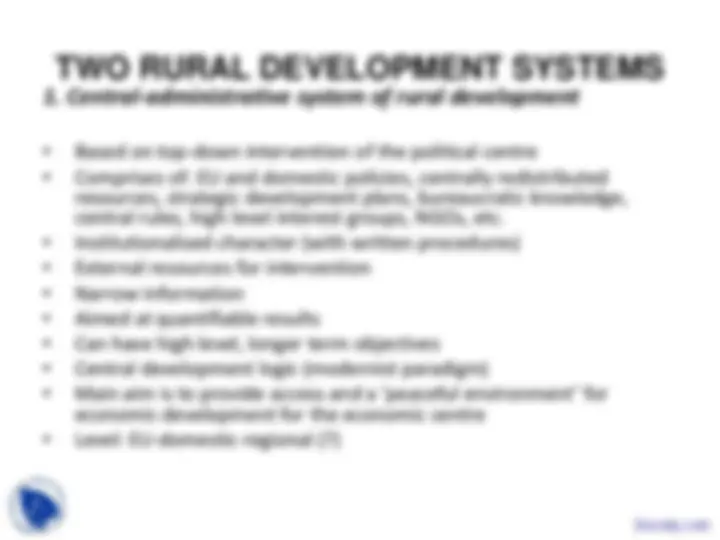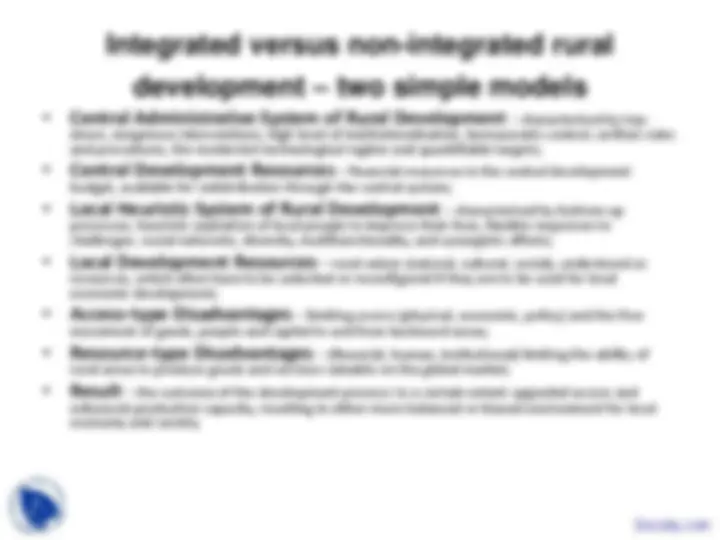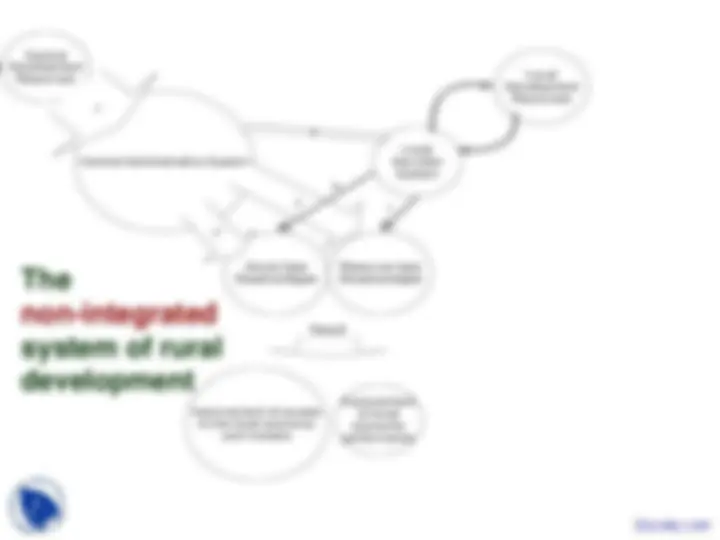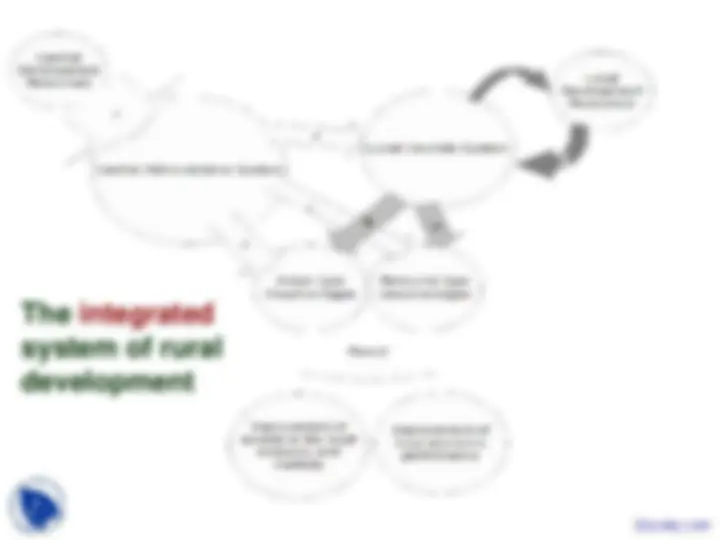Download Understanding Rural Development: An Analysis of Integrated versus Non-Integrated Systems and more Slides Human Development in PDF only on Docsity!
Disintegration, the reason for policy failure –
an analytical model of integrated rural
development
Introduction
Rural disadvantages - access and resources
Two rural development systems – ‘central administrative’ and
‘local heuristic’
Integrated versus non-integrated rural development – two
simple models
40 years’ of EU and domestic policies, positive discrimination
Everyday aspiration of local people to make rural life better
RESULTS:
Environmental and social degradation, depopulation, growing
geographical disparities, etc.
WHY RURAL POLICIES DO NOT WORK WELL?
HOW COULD WE DO BETTER?
TWO RURAL DEVELOPMENT SYSTEMS
Europeanisation = improving access, diminishing traditional protections, exposing rural areas to global (unequal) competition.
Rural development is:
- external (central) intervention
- to protect the loss of rural values during Europeanisation through: rules, financial aid, rural policies in general
- aspiration of local people
- to improve their own lives through: unlocking local resources and attracting external ones, searching for ‘new futures’
TWO RURAL DEVELOPMENT SYSTEMS
1. Central-administrative system of rural development
- Based on top-down intervention of the political centre
- Comprises of: EU and domestic policies, centrally redistributed resources, strategic development plans, bureaucratic knowledge, central rules, high level interest groups, NGOs, etc.
- Institutionalised character (with written procedures)
- External resources for intervention
- Narrow information
- Aimed at quantifiable results
- Can have high level, longer term objectives
- Central development logic (modernist paradigm)
- Main aim is to provide access and a ‘peaceful environment’ for economic development for the economic centre
- Level: EU-domestic-regional (?)
Human actors Local heuristic system:
- Local leaders, entrepreneurs, etc.
- Their work effects their lives – they risk their own money
- Embeddedness – moral control
- Insightful knowledge on local matters, but often little understanding of central rules
- Very committed and less objective
- Main concern is the betterment of rural life / non-quantifiable results
Central-administrative system
- Politicians, high level public servants, etc.
- Deal with others’ life, do not risk their own money
- High up in the system – broad vision, objectivity
- Under bureaucratic and political control
- Insightful knowledge of bureaucratic rules but low information on local
- Main concern is to comply with the political centre, accountability, transparency
- Risk evasion
Integrated versus non-integrated rural
development – two simple models
- Central Administrative System of Rural Development – characterised by top- down, exogenous interventions, high level of institutionalisation, bureaucratic control, written rules and procedures, the modernist technological regime and quantifiable targets;
- Central Development Resources – financial resources in the central development budget, available for redistribution through the central system;
- Local Heuristic System of Rural Development – characterised by bottom-up processes, heuristic aspiration of local people to improve their lives, flexible responses to challenges, social networks, diversity, multifunctionality, and synergistic effects;
- Local Development Resources – rural values (natural, cultural, social), understood as resources, which often have to be unlocked or reconfigured if they are to be used for local economic development;
- Access-type Disadvantages – limiting access (physical, economic, policy) and the free movement of goods, people and capital to and from backward areas;
- Resource-type Disadvantages – (financial, human, institutional) limiting the ability of rural areas to produce goods and services saleable on the global market;
- Result – the outcome of the development process: to a certain extent upgraded access and enhanced production capacity, resulting in either more balanced or biased environment for local economy and society.
The integrated
system of rural
development
Information flows in the non-integrated
development system
Central development system
developmen^ Local t system developmentsystem^ Local
development^ Local system
LI LI LI LI
LI LI LI
LI LI LI LI LI LI LI = local initiatives LI

